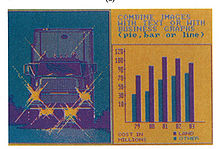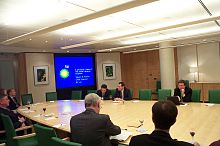- Presentation program
-
 A slide created by the first presentation graphics company, VCN ExecuVision, in 1982.
A slide created by the first presentation graphics company, VCN ExecuVision, in 1982.
A presentation program (also called a presentation graphics program) is a computer software package used to display information, normally in the form of a slide show. It typically includes three major functions: an editor that allows text to be inserted and formatted, a method for inserting and manipulating graphic images and a slide-show system to display the content.
Contents
Notable examples
- Microsoft PowerPoint
- Corel Presentations
- Google Docs
- Harvard Graphics (obsolete)
- IBM Lotus Freelance Graphics (obsolete)
- OpenOffice.org Impress (open source)
- SlideRocket
- Prezi
- Apple Keynote
History
 A presentation using PowerPoint.
A presentation using PowerPoint.
The presentation graphics software ran on computer workstations, such as those manufactured by Genigraphics, Autographix, and Dicomed. It became quite easy[dubious ] to make last-minute changes compared to traditional typesetting and pasteup. It was also a lot easier to produce a large number of slides in a small amount of time. However, these workstations also required skilled operators, and a single workstation represented an investment of $50,000 to $200,000 (in 1979 dollars).
In the mid-1980s developments in the world of computers changed the way presentations were created. Inexpensive, specialized applications now made it possible for anyone with a PC or Macintosh to create professional-looking presentation graphics.
Originally these programs were used to generate 35 mm slides, to be presented using a slide projector. As these programs became more common in the late 1980s several companies set up services that would accept the shows on diskette and create slides or print transparencies. In the 1990s dedicated LCD-based screens that could be placed on the projectors started to replace the transparencies, and by the late 1990s they had almost all been replaced by video projectors.
The first commercial computer software specifically intended for creating WYSIWYG presentations was developed at Hewlett Packard in 1979 and called BRUNO and later HP-Draw. The first software displaying a presentation on a personal computer screen was VCN ExecuVision, developed in 1982. This program allowed users to choose from a library of images to accompany the text of their presentation.
Features
A presentation program is supposed to help both: the speaker with an easier access to his ideas and the participants with visual information which complements the talk. There are many different types of presentations including professional (work-related), education, entertainment, and for general communication. Presentation programs can either supplement or replace the use of older visualaid technology, such as Pamphlets, handouts, chalkboards, flip charts, posters, slides and overhead transparencies. Text, graphics, movies, and other objects are positioned on individual pages or "slides" or "foils". The "slide" analogy is a reference to the slide projector, a device that has become somewhat obsolete due to the use of presentation software. Slides can be printed, or (more usually) displayed on-screen and navigated through at the command of the presenter. Transitions between slides can be animated in a variety of ways, as can the emergence of elements on a slide itself. Typically a presentation has many constraints and the most important being the limited time to present consistent information.
Recently a new presentation paradigm has emerged: zooming presentation programs. Instead of individual slides these ZUIs (zoom user interface) are based on one infinite canvas on which all content is presented. This allows for non-linear presentations, the option to present richer detail of content, and to give a better overview and understanding of complex visual messages and relations.
Another recent development which internet based software such as SlideRocket, Office Web Apps or Google Docs has enabled is collaborative development of the presentation. Several people can work on the presentation at the same time revising content or reviewing the changes as they are made by others.
Many presentation programs come with pre-designed images (clip art) and/or have the ability to import graphic images. Custom graphics can also be created in other programs such as Adobe Photoshop or Adobe Illustrator and then exported. The concept of clip art originated with the image library that came as a complement with VCN ExecuVision, beginning in 1983.
With the growth of digital photography and video, many programs that handle these types of media also include presentation functions for displaying them in a similar "slide show" format. For example, Apple's iPhoto allows groups of digital photos to be displayed in a slide show with options such as selecting transitions, choosing whether or not the show stops at the end or continues to loop, and including music to accompany the photos.
Similar to programming extensions for an operating system or web browser, "add ons" or plugins for presentation programs can be used to enhance their capabilities. For example, it would be useful to export a PowerPoint presentation as a Flash animation or PDF document. This would make delivery through removable media or sharing over the Internet easier. Since PDF files are designed to be shared regardless of platform and most web browsers already have the plugin to view Flash files, these formats would allow presentations to be more widely accessible.
Certain presentation programs also offer an interactive integrated hardware element designed to engage an audience (e.g. audience response systems) or facilitate presentations across different geographical locations (e.g. web conferencing). Other integrated hardware devices ease the job of a live presenter such as laser pointers and interactive whiteboards.
See also
In alphabetic order:
- Adobe Persuasion
- Apple Keynote
- Beamer (LaTeX)
- Digitalsoft Keypoint
- Google Docs
- IBM Lotus Freelance Graphics
- IBM Lotus Symphony
- IPE Presentations
- KPresenter
- Office Web Apps
- PowerPoint
- Prezi
- S5 Web-Based Presentation Format
- Slide Effect
- SlideRocket
- SlideShare
- SoftMaker Presentations
- Worship presentation program
- Zoho
Presentation software Software Beamer · Calligra Stage · Ease · MagicPoint · OpenOffice.org Impress · LibreOffice Impress · NeoOffice · Powerdot · Simple Slides · Tech Talk PSEAdobe Acrobat · Apple Keynote · Corel Presentations · Harvard Graphics · IBM Lotus Freelance Graphics · Microsoft PowerPoint · SoftMaker PresentationsauthorSTREAM · Brainshark · Docstoc · Google Docs · Prezi · Scribd · SlideRocket · SlideShare · wePapers · Others...DiscontinuedFormats CategoryCategories:- Presentation software
Wikimedia Foundation. 2010.
